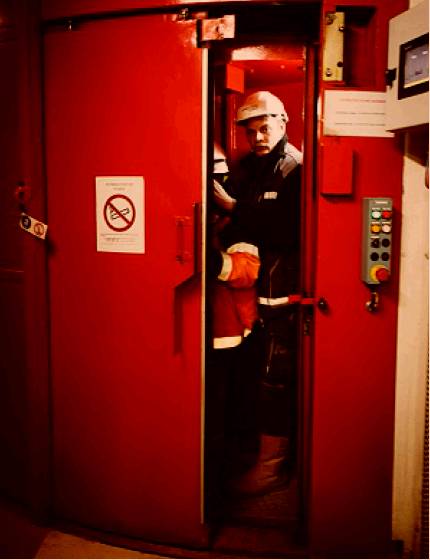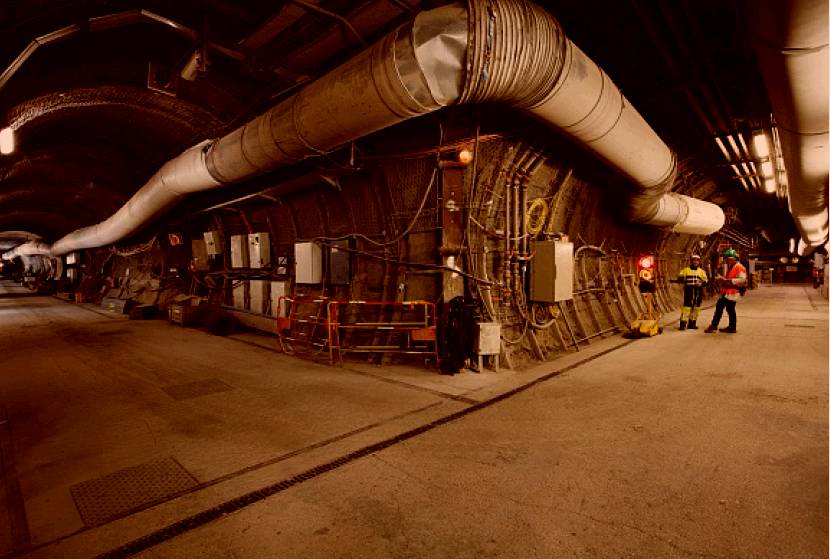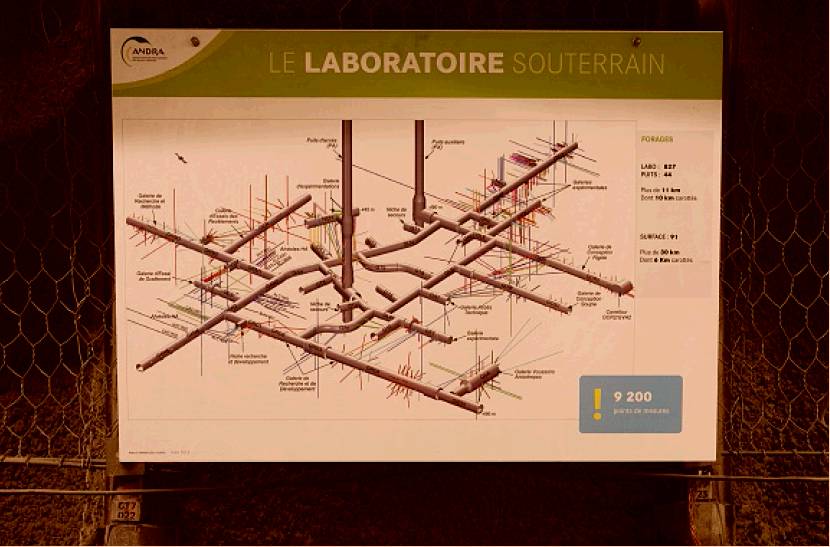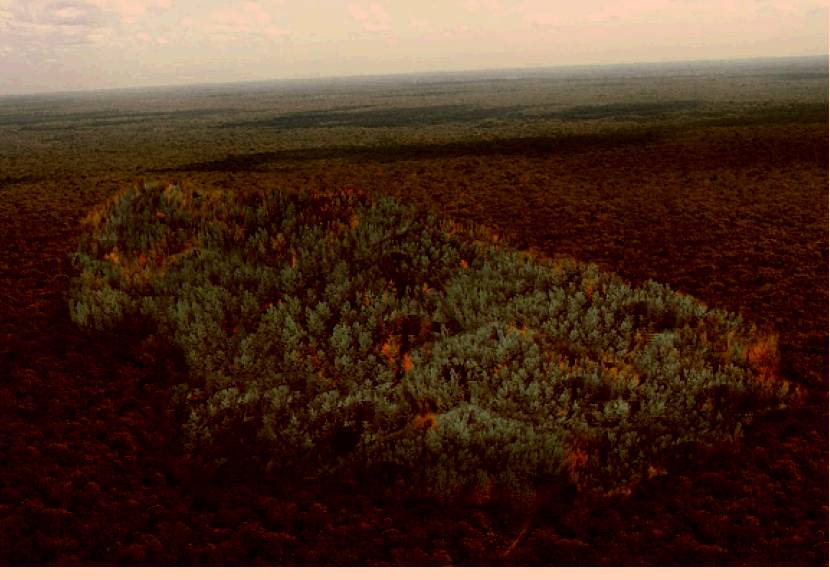KEEP OUT FOR 100,000 YEARS
How do we stop future generations being killed by radioactive waste? Nuclear agencies are searching for the signs, language and solutions that will warn our descendants to stay away. Michael Stothard reports. Photographs by Nicolas Guiraud
We are in a red metal cage bumping slowly down a mineshaft to our destination, half a kilometre under the ground near the small town of Bure in eastern France. Above us are yellow fields of oilseed rape. Below is the maze of reinforced concrete tunnels that, if it wins final approval from the French government, will from 2025 be the last resting place for the most destructive and indestructible waste in history. This is the €25bn deep geological storage facility for France’s high and medium-level radioactive waste, the residue of more than half a century of nuclear power. When the work here is finally finished, no one must ever take this journey again or, at least, not for 100,000 years.
France is the world’s largest exporter of electricity and the world’s most committed nuclear nation, with 58 reactors producing 75 per cent of the country’s power. As aresult, it also produces enough toxic radioactive waste every year to fill 120 double-decker buses (about 13,000 cubic metres worth, or 2kg a year for every French person). The challenge at Bure isnot only to build a massive dump for radioactive trash but also to guard it from human intervention for an impossible amount of time – more than 4,000 human generations.
Our cage stutters and almost comes to a halt. The French workers dangling with me continue chatting about their shifts, but I quickly check the emergency oxygen tank on my belt. When we finally reach the cavern floor, we are at the start of a 1.6km network of winding laboratory tunnels. The air is thick and dusty; dozens of men in blue and grey overalls drill into the walls with car-sized machines. Others walk around checking the scientific equipment embedded in the rock. Above us, the curved grey ceilings are covered by a dense thicket of wires and tubes sending data back to technicians on the surface.
The waste, which will be placed in a quarter of a million sealed containers slotted into horizontal tunnels more than 100m long, is the byproduct of burning uranium in the nuclear reactors and includes some of the most deadly and long-lasting radionuclides in the world. Chlorine-36 has a half-life of 300,000 years and neptunium-237 a half-life of 2 million years. People do not often come into direct contact with such materials, aside from in a nuclear accident, but those that do meet a horrific end. In 1987, thieves in Brazil stole a source of high-level radiation from an old abandoned hospital. It was sold, its lead case broken open. After three days, four people who were handling it began to suffer internal bleeding in their limbs, eyes and digestive tracts, according to doctors. Then their hair fell out. Within weeks, they were dead.
Since France’s first nuclear power plant opened in 1956, the country has housed its high-level toxic waste in four short-term national surface facilities at La Hague in Normandy, Marcoule and Cadarache in the south and Valduc, north of Dijon. This was always seen asa stop-gap solution. The buildings have high security but were not designed to last more than a few decades, let alone keep the waste inaccessible for the 100,000 years and more that it will remain dangerous. In the 1970s and 1980s, nuclear agencies in France and around the world toyed with the idea of firing the waste into space in a rocket or putting it deep in the ocean. Both were eventually rejected as too dangerous, with fears that arocket could explode in the atmosphere and the radiation could leak into the ocean.
Eventually, in the 1990s, governments and scientists seemed to have converged on the idea of burying the radioactive waste in storage facilities designed to last for ever. The waste would be sealed hundreds of metres below ground in geological formations of clay, rock salt and granite that have not moved for millions of years. Deep underground disposal would, it was said, protect the waste from human interference, earthquakes or climate change. Greenpeace and other environmental groups, however, disagreed. They argued – and continue to believe – it is impossible to predict whether such storage will offer enough protection from radioactivity escaping in the long term.
Nevertheless, deep underground storage remains policymakers’ favoured solution. The only operative site today is the Waste Isolation Pilot Plant (WIPP) in south-east New Mexico, in the US, a deep repository for the disposal of weapons-related radioactive waste that was opened in 1999. But the rest of the world is catching up. A site in Finland has already been approved by regulators and in Sweden, Japan, Germany and France geological sites have been identified, although not confirmed. Nuclear waste authorities in Canada and Britain are looking at possible sites. The eventual location of a US site for civilian nuclear waste is still under discussion.
All these nuclear agencies have two problems, however, as they try to devise schemes that will win regulatory approval for deep geological repositories. The first is to design a site that can last for ever, even as tectonic plates shift and a new ice age – which scientists expect to occur within 100,000 years – radically erodes the soil above. The nightmare scenario is that the radioactive elements will seep out into the groundwater, gradually, silently poisoning wildlife and humans. In Germany the Asse former salt mine, where 126,000 drums of nuclear waste were buried in the 1970s, is already collapsing, forcing the authorities to dig up the dangerous material to place it elsewhere.
The second issue is that all nuclear agencies have a duty to try to prevent radioactive sites from being disturbed by future civilisations, who may decide to excavate an area in ignorance or even in the misguided hope of finding some kind of treasure buried underground. To this end, they are trying to find a way to communicate with the distant future, in order to warn its inhabitants about what will happen if they become too curious, and also to encourage them to look out for any technical problems at the site. This is not just a moral obligation. In the US, for example, there is a legal obligation to try to keep the “memory” of the site alive so that it can be managed “in perpetuity”.
This is a mind-bending task. About 100,000 years ago Europe was populated by a different species of human, Homo neanderthalensis. We know they had heavy, ape-like facial features, and used basic hunting tools, but we have no knowledge of the language they used. We have no idea what will happen in the next hundred thousand years, and what kinds of societies will populate the planet, let alone how we might communicate with them. Will they even understand our language? A large part of the written Mayan language, used until the 17th century in Central America, is indecipherable to us today.
The trefoil, the international warning symbol for radiation – three black blades on a yellow background –was created in 1946 and is still poorly understood. In 2007, after a five-year study across 11 countries, the International Atomic Energy Agency found that the symbol “has no intuitive meaning and little recognition beyond those educated in its significance”; only 6 per cent of those questioned in Kenya, India and Brazil knew what it meant. A more complex sign, in red, showing waves radiating from the trefoil, a skull and crossbones and a figure running away, designed to be more intuitive, was introduced in 2007. But will this be understood as a symbol for danger for 100,000 years? More worryingly, will future civilisations heed the warning even if they do understand it?
Patrick Charton is one of the world’s leading experts on this quasi-philosophical problem. He is head of a special “memory” division within the French nuclear agency, Andra, responsible for looking at ways in which we can keep alive the memory of nuclear storage facilities. It is his job, effectively, to communicate with the future.
“We have a duty of care to try and keep the site from being forgotten, to warn future generations about what is there,” he says, on a rainy afternoon in his office on the outskirts of Paris. “Clearly, it is not easy though… How do you write a message that lasts thousands of years? What language do you use? What do you even say?”
The first attempts to answer this tricky question date back to the late 1980s and early 1990s in the US. Acknowledging the limits of pure scientists to solve the problem, the Department of Energy commissioned a group of sociologists, science-fiction writers, futurists and artists to help create a design for a long-term warning to place on top of the WIPP depository in New Mexico. They came up with a series of recommendations. First, build a “message wall” in granite on top of the site and chisel a message – in seven languages from Chinese to Navajo – into the slabs. The proposed message, a lengthy explication, was designed to instil fear into those who could understand it. Part of it reads:
“This place is not a place of honor… no highly esteemed deed is commemorated here… nothing valued is here.
What is here was dangerous and repulsive to us. This message is a warning about danger.
The danger is in a particular location… it increases toward acenter… the center of danger is here… of a particular size and shape, and below us.
The danger is still present, in your time, as it was in ours.
The danger is to the body, and it can kill.
The form of the danger is an emanation of energy. The danger is unleashed only if you substantially disturb this place physically. This place is best shunned and left uninhabited.”
‘We have a duty of care to warn future generations about what is there. How do you write a message that lasts thousands of years? What language do you use? What do you even say?’
Patrick Charton, head of a special “memory” division at the French nuclear agency Andra
It was also suggested that alarger series of “markers” should be erected on the site – an imposing signal, beyond the written word, that would be “non-natural, ominous and repulsive” – in case our languages do not survive. A series of terrifying designs was proposed, one of which was to cover the entire ground surface with giant concrete spikes. The spikes and their shadows, it was thought, would always communicate danger. The contorted face of Edvard Munch’s painting “The Scream” was proposed for the warning signs that were to be scattered across the site.
The final designs for the warning markers do not need to be submitted to the US government until about 2035, as the facility will not be closed until about 2050. Today, the official proposal is to have 48 granite monuments around the site, each standing eight metres tall and weighing 20 tons. But the idea of giant granite blocks – trying to scare the future into submission – is already going out of style. Charton calls it a “classic American solution” – “very big” but also ugly, and “there is always a risk ugly things will be destroyed” by locals.
Another criticism is more fundamental. The history of archaeology and tomb raiding suggests that warnings have a tendency to be ignored or, worse, to incite curiosity. The pharaohs’ tombs in Egypt, hidden deep below the desert, were raided in spite of dire curses warning against it. Indiana Jones is a hero for breaking rules, not keeping them. “Humans are naturally curious,” says Charton. “Warnings are an invitation.”
Abraham Van Luik, a philosophically minded geoscientist who works at the WIPP facility, agrees that the idea of scaring future generations is flawed and that the final design submissions for the site will be very different. “Parents attempt to control children with emotions like guilt or fear, with mixed and unpredictable results,” he says. “If you tell people not to touch the red button, but don’t say why, what will they do? Our thinking today is we want to treat future generations like adults and just give them facts to prevent them from doing anything in ignorance.” He adds that giant granite slabs would be “monstrously” expensive.
While the Americans have been experimenting with designs that instil fear on a grand scale, the Scandinavian countries have taken a quieter approach. The deep geological repository at Onkalo, on the west coast of Finland, which will begin operations in 2023, is at the moment designed to leave no trace on the landscape. In the frozen tundra – so the thinking goes – far from any oil or precious minerals, what are the chances that anyone would choose to dig 400m underground? “The idea is that the facility will be safe for ever, even if the memory is lost,” says Kai Hämäläinen from the Finnish nuclear safety authority. “There is no requirement in the legislation for any kind of marker.”
This approach, like the American one, has suffered a backlash. The argument has a fatal flaw, say
The challenge is not only to build a massive radioactive dump but to guard it from human intervention for an impossible amount of time








